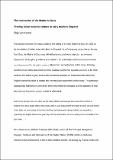Files in this item
The inventories of the Madre de Deus : tracing Asian material culture in early modern England
Item metadata
| dc.contributor.author | van Kessel, Elsje | |
| dc.date.accessioned | 2021-04-15T23:49:18Z | |
| dc.date.available | 2021-04-15T23:49:18Z | |
| dc.date.issued | 2020-07 | |
| dc.identifier | 258518794 | |
| dc.identifier | b350c8cf-d4f4-414f-9e3f-8951ac704343 | |
| dc.identifier | 85094979393 | |
| dc.identifier | 000582311100001 | |
| dc.identifier.citation | van Kessel , E 2020 , ' The inventories of the Madre de Deus : tracing Asian material culture in early modern England ' , Journal of the History of Collections , vol. 32 , no. 2 , pp. 207-223 . https://doi.org/10.1093/jhc/fhz015 | en |
| dc.identifier.issn | 0954-6650 | |
| dc.identifier.other | ORCID: /0000-0002-0267-5154/work/64697895 | |
| dc.identifier.uri | https://hdl.handle.net/10023/23036 | |
| dc.description | This article was made possible by the generous financial support of the Leverhulme Trust, and by the hospitality of cham – Centre for the Humanities at the Universidade Nova de Lisboa. | en |
| dc.description.abstract | This article examines the impact made by the taking of the ship Madre de Deus in 1592 on the circulation of Asian material culture in England. As a Portuguese cargo ship on its way from Goa, the Madre de Deus was filled with precious and exotic objects – an immense treasure for the English privateers who seized it. An examination of the extensive archival record generated by the ship’s capture allows for a reconstruction of the cargo. Probing inventories and other documents for their material and formal qualities as much as for their contents, the article argues that written documents became an instrument with which the English authorities tried to control the uncontrollable movements of the booty. The pathways subsequently followed by some of the items recovered are traced, and the question of how they affected England’s artistic culture is addressed. | |
| dc.format.extent | 17 | |
| dc.format.extent | 327156 | |
| dc.language.iso | eng | |
| dc.relation.ispartof | Journal of the History of Collections | en |
| dc.subject | AC Collections. Series. Collected works | en |
| dc.subject | CD921 Archives | en |
| dc.subject | DA Great Britain | en |
| dc.subject | DS Asia | en |
| dc.subject | N Fine Arts | en |
| dc.subject | T-NDAS | en |
| dc.subject | BDC | en |
| dc.subject | R2C | en |
| dc.subject.lcc | AC | en |
| dc.subject.lcc | CD921 | en |
| dc.subject.lcc | DA | en |
| dc.subject.lcc | DS | en |
| dc.subject.lcc | N | en |
| dc.title | The inventories of the Madre de Deus : tracing Asian material culture in early modern England | en |
| dc.type | Journal article | en |
| dc.contributor.sponsor | The Leverhulme Trust | en |
| dc.contributor.institution | University of St Andrews. School of Art History | en |
| dc.identifier.doi | https://doi.org/10.1093/jhc/fhz015 | |
| dc.description.status | Peer reviewed | en |
| dc.date.embargoedUntil | 2021-04-16 | |
| dc.identifier.grantnumber | RF-2017-348 | en |
This item appears in the following Collection(s)
Items in the St Andrews Research Repository are protected by copyright, with all rights reserved, unless otherwise indicated.

